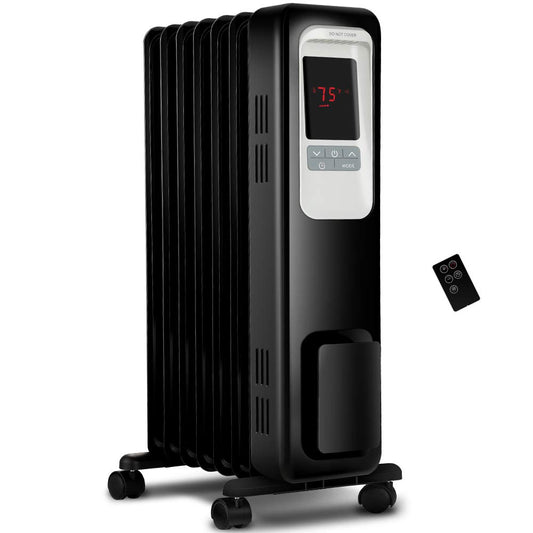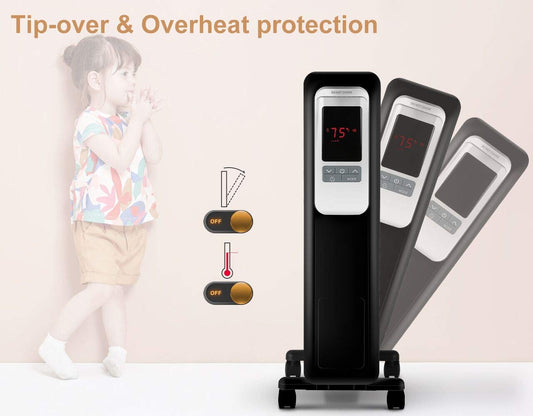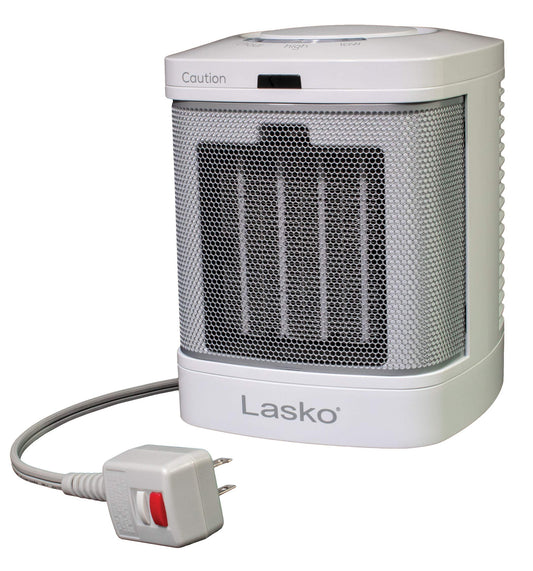How much energy do space heaters use?
Space Heaters 101 - A Complete Guide for your Airbnb
Summary
Space heaters are a convenient way to warm up your Airbnb, but they can also consume a lot of energy. In this article, we will show you how to calculate the energy usage of different types of space heaters, and how to reduce your heating costs with some simple tips.

Some links affiliate links that we may earn a commission.
Introduction
Welcome, fellow travelers and home enthusiasts! Today, we're diving into the cozy world of space heaters and the burning question on everyone's mind: how much energy do these nifty gadgets really use? As an Airbnb super host and avid traveler, I know the importance of creating a warm and inviting space, especially when the temperatures drop.
Whether you're jet-setting to exotic destinations or hosting guests in the comfort of your own home, understanding the ins and outs of space heaters is key to keeping things warm and toasty without breaking the bank. In this article, we'll explore the inner workings of space heaters, their energy efficiency, and provide some valuable insights to make your space heating experience both economical and efficient. So buckle up for a journey into the world of warmth and energy savings!
What is a Space Heater?
Before we jump into the energy details, let's get acquainted with our trusty companion – the space heater. A space heater is a compact, portable device designed to heat a specific area or room. Think of it as your personal heat wizard, bringing warmth wherever it's needed most.
These handy devices come in various shapes and sizes, each with its own set of features and heating technologies. Whether it's the radiant warmth of infrared heaters, the quick and efficient ceramic heaters, or the classic oil-filled models, there's a space heater for every heating need.
Perfect for chilly nights, drafty spaces, or simply adding extra warmth to your favorite corner, space heaters are versatile and energy-efficient solutions. Now that we've got the basics covered, let's delve into how these magical devices work their heating wonders!
How Space Heaters Work
Ever wondered about the science behind that comforting warmth? Space heaters operate on the principle of converting electrical energy into heat, creating a cozy oasis in no time.
Here's the lowdown on their heating mechanisms:
- Ceramic Heaters: These employ ceramic heating elements, swiftly heating up and radiating warmth. They're quick on the draw, providing instant heat.
- Infrared Heaters: Harnessing infrared radiation, these heaters emit heat that warms objects directly, making them an efficient choice for targeted warmth.
- Oil-Filled Heaters: Filled with diathermic oil, these heaters heat the oil, which then circulates through the unit, maintaining a steady and gentle warmth.
- Convection Heaters: Operating through convection currents, these heaters warm the air, creating a consistent and even heat distribution throughout the space.
Understanding the mechanics of your space heater helps you make informed choices based on your heating preferences and the specific needs of your space. As we unravel the mystery of energy usage, keep in mind how these mechanisms play a role in keeping you snug and warm!
Factors That Determine Energy Use
Now that we're warmed up to the workings of space heaters, let's explore the factors that influence their energy consumption. Being mindful of these elements can help you make savvy decisions for efficient heating without the shocking electric bill.
How much energy do space heaters use? Here are the key players:
- Heating Technology: Different types of space heaters have varying energy efficiencies. Ceramic and infrared heaters often provide quick bursts of heat, while oil-filled and convection heaters maintain a more consistent warmth.
- Wattage: The power rating of your space heater, measured in watts, directly impacts its energy consumption. Higher wattage generally means more heat, but it's crucial to find the right balance for your space.
- Duration of Use: Common sense, but worth noting – the longer you run your space heater, the more energy it consumes. Utilize timers and thermostat settings to optimize usage.
- Room Size: A petite heater for a vast room? Not the most efficient choice. Ensure your space heater matches the size of the area you want to warm for optimal energy utilization.
As we unravel the intricacies of energy use, keep these factors in mind for a cozy, cost-effective heating experience. Next, we'll crunch the numbers and reveal the average energy use and costs associated with these warming wonders!
Average Energy Use and Costs
Time to demystify the numbers! Let's break down the average energy consumption and costs associated with using space heaters. Knowing what to expect can empower you to make informed decisions for both your comfort and your wallet.
Firstly, energy use is measured in kilowatt-hours (kWh). The formula to calculate energy consumption is straightforward:
Energy Consumption (kWh) = Wattage (W) × Hours of Use / 1000
Now, let's get into the nitty-gritty:
- Small Ceramic Heaters (750-1500W): These typically consume 0.75 to 1.5 kWh per hour, costing around $0.09 to $0.18 per hour based on the national average electricity rate.
- Larger Infrared Heaters (1500-3000W): Expect energy consumption of 1.5 to 3 kWh per hour, translating to approximately $0.18 to $0.36 per hour.
- Oil-Filled Heaters (600-1500W): With a more consistent heat output, these use around 0.6 to 1.5 kWh per hour, costing approximately $0.07 to $0.18 per hour.
- Convection Heaters (750-1500W): Similar to ceramic heaters, they average 0.75 to 1.5 kWh per hour, with costs ranging from $0.09 to $0.18 per hour.
These estimates can vary based on electricity rates in your area. Armed with this knowledge, you can now navigate the sea of space heaters, making choices that align with both your heating needs and budget. Stay tuned as we explore the diverse types of space heaters in the next section!
Types of Space Heaters
Now that we've got a handle on energy usage and costs, let's explore the diverse landscape of space heaters. From the quick-warming ceramic companions to the steady and reliable oil-filled units, there's a heater for every heating preference and space requirement.
Here's a snapshot of the main types:
- Ceramic Heaters: Fast and efficient, these heaters use ceramic heating elements to provide instant warmth. Perfect for smaller spaces and quick heating needs.
- Infrared Heaters: Harnessing infrared radiation, these heaters deliver targeted warmth by heating objects directly. Ideal for creating a cozy spot in larger rooms.
- Oil-Filled Heaters: Known for their steady and gentle warmth, these heaters are filled with diathermic oil, offering consistent heating over time.
- Convection Heaters: Operating through convection currents, these heaters warm the air and ensure even heat distribution throughout the space.
Each type comes with its unique set of features, making it crucial to choose the one that aligns with your specific heating needs. As we journey through the world of space heaters, we'll uncover the safety tips and tricks to ensure your heating experience is not only warm but also secure. Stay tuned for the next installment of our space heater exploration!
Safety Tips
Before we fully immerse ourselves in the warmth of space heaters, let's prioritize safety. While these devices are fantastic for heating, it's crucial to use them responsibly to prevent any unwanted surprises. Here are some essential safety tips to keep in mind:
- Placement Matters: Keep your space heater on a flat, non-flammable surface and maintain a minimum clearance of three feet from combustible materials. This ensures proper ventilation and reduces the risk of fire hazards.
- Tip-Over Protection: Invest in heaters with a tip-over switch that automatically shuts off the unit if it's knocked over. This adds an extra layer of safety, especially in homes with curious little ones and furry friends.
- Overheat Protection: Opt for heaters equipped with overheat protection features. These smart devices automatically turn off if they detect excessive heat, preventing potential accidents.
- Cord and Plug Safety: Inspect cords for any damage and never use an extension cord for your space heater. Plug directly into a wall outlet, ensuring the electrical capacity matches the heater's requirements.
By incorporating these safety measures into your space heater routine, you can enjoy the cozy warmth without compromising on well-being. Now, let's turn up the heat on energy efficiency with some savvy tips in the next section!
Tips for Maximizing Energy Efficiency
Now that we've covered safety essentials, let's dial in on another crucial aspect: maximizing the energy efficiency of your space heater. It's not just about staying warm; it's about doing so smartly and economically. Here are some tips to help you make the most of your heating experience:
- Optimal Placement: Position your space heater strategically to target the areas you want to warm the most. Avoid heating empty spaces, and close doors and windows to retain warmth.
- Use a Thermostat: Choose a heater with a built-in thermostat to maintain a consistent temperature. This prevents unnecessary energy consumption by shutting off when the desired warmth is achieved.
- Utilize Timers: Set timers to turn your space heater on and off according to your schedule. This ensures you only use energy when needed, offering both comfort and savings.
- Dress Warmly: Layer up! By wearing warm clothing indoors, you can lower the thermostat on your heater without sacrificing comfort, reducing overall energy consumption.
By incorporating these energy-efficient practices, you'll not only stay snug but also keep your energy bills in check. As we navigate the myths surrounding energy efficiency in the next section, you'll gain even more insights into smart heating strategies. Stay tuned!
Common Myths About Energy Efficiency
Let's debunk some myths that might be chilling your understanding of space heater efficiency. It's time to separate fact from fiction and ensure you're making informed decisions for your heating needs. Here are a few common misconceptions:
- Myth: Space Heaters Consume Too Much Energy: The truth is, with proper usage and energy-conscious practices, space heaters can be efficient and cost-effective, providing targeted warmth without skyrocketing your bills.
- Myth: All Space Heaters Are the Same: Different types of space heaters come with varying energy efficiencies. Understanding the specific features and heating mechanisms of each type allows you to choose the one that suits your needs and budget.
- Myth: Cranking Up the Thermostat Is Always Better: Setting your space heater to an excessively high temperature doesn't necessarily result in quicker or better heating. Optimal thermostat settings ensure comfort without unnecessary energy consumption.
- Myth: Space Heaters Are Unsafe: While safety is a top priority, modern space heaters come with advanced safety features such as tip-over protection and overheat sensors. Following safety guidelines makes them a secure heating option.
Now that we've dispelled these myths, you can confidently navigate the world of space heaters, making choices that align with both efficiency and safety. In the following section, we'll delve into broader recommendations for energy-efficient heating and cooling. Stay tuned for more insights!
Recommendations for Energy-Efficient Heating and Cooling
As we wrap up our exploration of space heaters, let's broaden our perspective to encompass overall recommendations for energy-efficient heating and cooling. Whether you're a travel enthusiast like me or a homebody creating a cozy Airbnb experience, these tips will keep you in control of your comfort and energy costs:
- Smart Thermostats: Invest in a programmable thermostat for your home. This allows you to set specific temperatures for different times of the day, optimizing comfort and minimizing unnecessary energy use.
- Regular HVAC Maintenance: Keep your central heating and cooling systems in top shape with regular maintenance. Clean filters, check for leaks, and ensure all components are running efficiently.
- Insulation and Sealing: Proper insulation and sealing gaps in doors and windows play a significant role in maintaining a comfortable temperature. This reduces the workload on your heating and cooling systems, translating to energy savings.
- Utilize Natural Ventilation: When the weather permits, open windows and let the natural breeze regulate your indoor temperature. This eco-friendly approach minimizes the need for artificial heating or cooling.
By incorporating these recommendations into your overall heating and cooling strategy, you'll create a more sustainable and cost-effective living environment. As we approach the finale of our space heater journey, we'll weigh the pros and cons of these warming wonders. Stay with us for the grand conclusion!
Pros and Cons of Space Heaters
Before we bid adieu to our space heater odyssey, let's weigh the pros and cons of these warming companions. Understanding the advantages and potential drawbacks ensures you make an informed decision based on your unique heating needs:
Pros:
- Targeted Heating: Space heaters allow you to heat specific areas, saving energy by avoiding heating the entire house.
- Portability: Their compact and portable design makes them versatile, providing warmth where and when you need it.
- Energy Efficiency: With proper usage and consideration of factors like wattage and heating technology, space heaters can be energy-efficient alternatives.
- Quick Warm-up: Many types of space heaters provide rapid heating, ensuring you don't have to wait long for that cozy ambiance.
Cons:
- Limited Coverage: While effective for targeted heating, space heaters might struggle to warm larger or open-concept spaces.
- Constant Supervision: Safety is paramount, and using space heaters requires vigilant monitoring to prevent accidents and ensure proper operation.
- Initial Cost: High-quality space heaters with advanced features can come with a higher upfront cost, although the long-term energy savings may balance this out.
Now equipped with a comprehensive understanding of space heaters, you can confidently choose the type that aligns with your lifestyle and heating preferences. As we approach the conclusion, stay tuned for some parting thoughts on our journey through the world of warmth and energy efficiency!
Conclusion
Congratulations, fellow warmth seekers, on completing our expedition into the realm of space heaters and energy efficiency! Whether you're a jet-setting adventurer like me or a homebody creating a snug Airbnb retreat, understanding the nuances of space heaters empowers you to make cozy and cost-effective choices.
From unraveling the science behind different heating technologies to dispelling common myths and exploring broader recommendations for energy-efficient living, we've covered it all. As we part ways, keep these key takeaways in mind:
- Choose the right type of space heater based on your heating needs and room size.
- Implement safety measures to enjoy warmth without worry.
- Maximize energy efficiency with smart practices like optimal placement and thermostat usage.
- Consider overall home heating and cooling strategies for a sustainable and comfortable living environment.
- Weigh the pros and cons to make an informed decision on whether a space heater suits your lifestyle.
Whether you're chasing sunsets in faraway lands or creating a cozy haven at home, may your spaces be warm, inviting, and energy-efficient. Safe travels and happy heating!

















